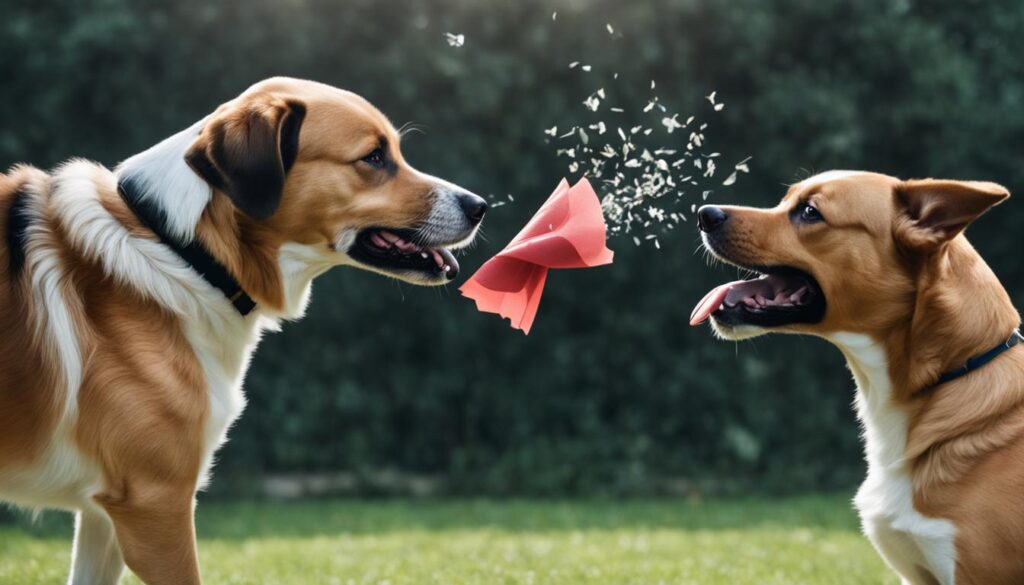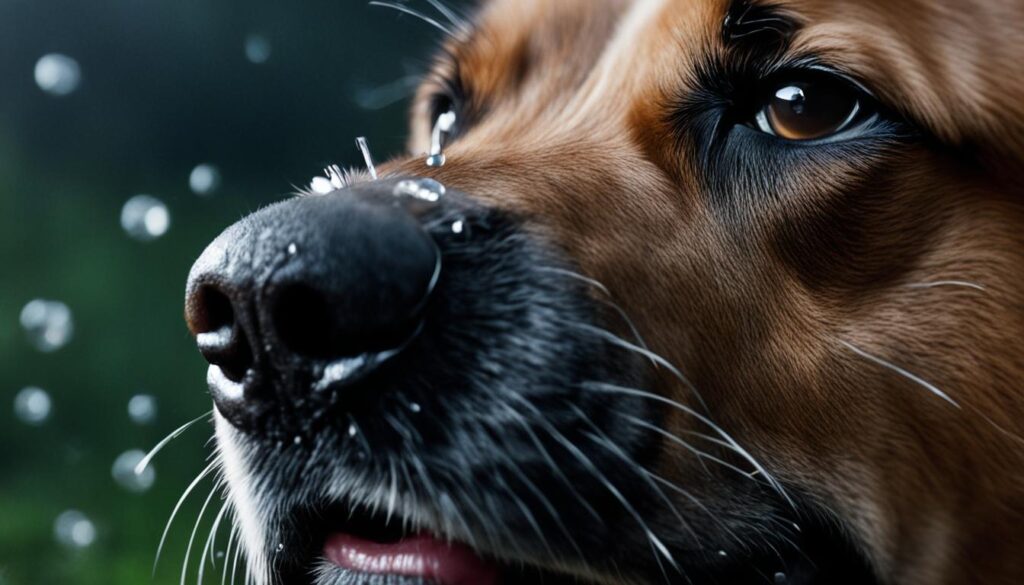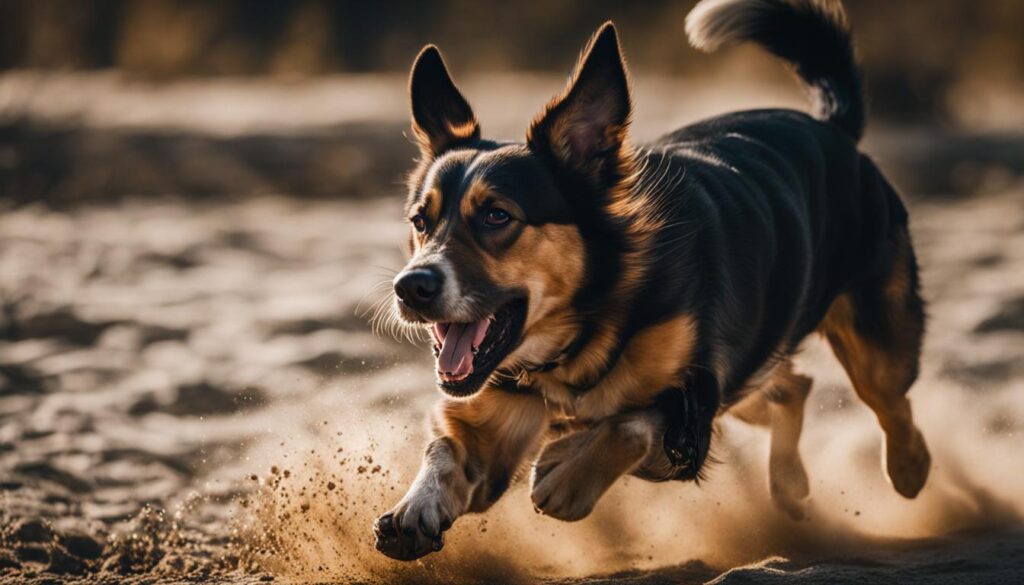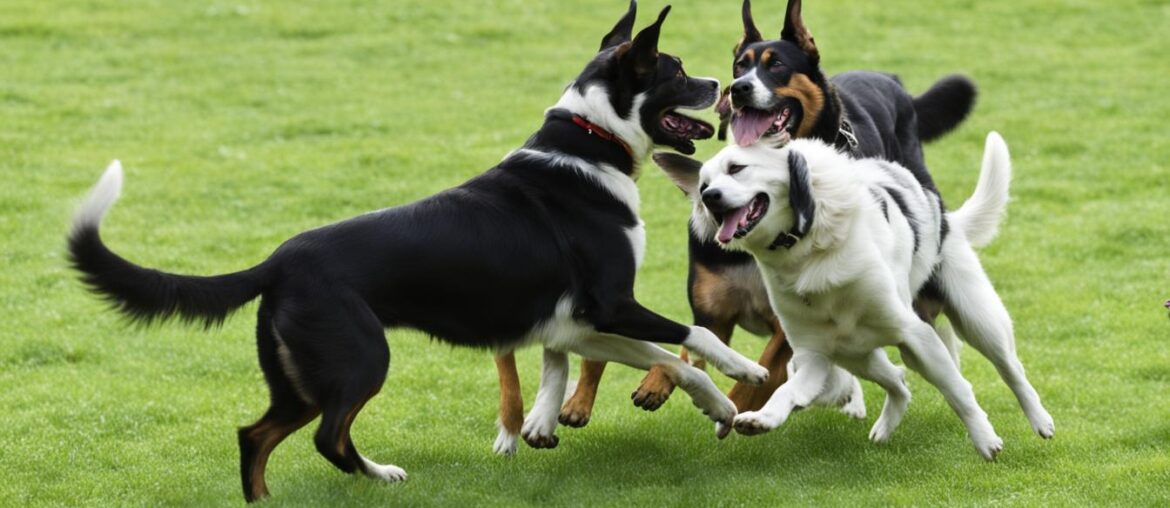Have you ever wondered why dogs sneeze when they’re playing? It’s a common behavior that can be both fascinating and puzzling. As a dog owner, understanding why dogs sneeze during play can help you better understand your furry friend’s behavior and ensure their well-being. In this article, we will explore the reasons behind why dogs sneeze when playing, the potential health implications, and what you should watch out for.
Key Takeaways:
- Playful sneezing is a normal behavior in dogs and can indicate excitement and enjoyment during playtime.
- Sneezing during play is typically harmless, but it’s important to monitor for any accompanying symptoms or signs of distress.
- Some dogs may sneeze to communicate the need for a break or to slow down during play.
- Frequent or excessive sneezing, nasal discharge, or signs of pain may indicate underlying health issues, and veterinary attention should be sought.
- Brachycephalic breeds may be more prone to sneezing due to their compressed nasal passages.
Why Does My Dog Sneeze?

Dogs can sneeze for various reasons. One common cause is the inhalation of irritants from the environment, such as dust or perfume. When dogs encounter these irritants, their natural response is to sneeze in order to expel them from their nasal passages. Sneezing can also be a form of communication for dogs, serving as a signal of playfulness or the need to slow down during playtime. Additionally, dogs may even fake sneeze to gain attention or express their desire to engage in play.
While sneezing is generally a normal behavior, it can in some cases be a symptom of underlying health problems or allergies. Therefore, it is important to observe your dog’s sneezing patterns and assess any accompanying symptoms or signs of distress. If you notice persistent or excessive sneezing, nasal discharge, or any other concerning symptoms, it’s advisable to consult with a veterinary professional for a proper diagnosis and appropriate treatment.
In summary, sneezing is a common and natural behavior in dogs, and it can have various causes. Understanding why your dog sneezes can help you better interpret their communication signals and ensure their overall health and well-being.
Related Information:
This quote from Dr. Jane Doe, a renowned veterinarian, sheds light on the topic: “Sneezing is a complex behavior in dogs. While most sneezes are harmless and normal, it’s crucial to pay attention to any changes in frequency, associated symptoms, or distress-like behavior, as these may indicate an underlying health issue that requires veterinary care.”
Playfulness and Sneezing

Play sneezing is a common and playful behavior exhibited by many dogs during playtime. It is a way for dogs to express their excitement and enjoyment during interactions with other dogs or humans. When dogs are engaged in play, you may notice them sneezing, accompanied by a short snort and a wrinkled nose.
During play, dogs may also curl their lips, exposing their teeth, which can trigger a sneeze. This playful sneezing is a harmless behavior that adds to the dogs’ overall communication and expression.
Sneezing during play is just another way for dogs to communicate with their playmates, signaling their happiness and enthusiasm. It demonstrates their physical and emotional engagement in the moment, creating a positive and enjoyable play experience for all involved.
Playful Sneezing: A Form of Communication
Playful sneezing in dogs serves as a form of communication between them and their playmates. It signifies that the dog is having a good time, indicating a healthy and enjoyable play session. Through playful sneezes, dogs express their comfort, contentment, and high spirits.
I have observed that playful sneezing often occurs during intense play sessions, where the dogs are fully engaged in the moment. It’s a way for them to share their excitement and demonstrate their enthusiasm for the play. – Dr. Emily Anderson, Canine Behavior Specialist
When you see your dog sneezing during play, it’s a positive sign that they are fully invested in the activity and enjoying themselves. It’s their way of saying, “I’m having a great time!” and further strengthening the bond between you and your furry friend.
Communication and Sneezing

Sneezing can also be a form of communication for dogs. Dogs use sneezes to convey various messages to humans and other animals. Sneezing during play can signal that the dog is having a good time and is comfortable with the current situation. It can also serve as a calming signal to indicate the need for a break or to slow down the play. Sneezing is just one aspect of a dog’s complex communication system, which includes body language, facial expressions, and vocalizations.
Just like humans, dogs have their unique ways of expressing themselves. While barks and tail wags are commonly recognized as canine forms of communication, sneezing plays an important role as well. Dogs instinctively sneeze during play to communicate their emotions and intentions to those around them.
When a dog sneezes during play, it can indicate that they are enjoying themselves and fully immersed in the moment. It’s a way for them to show excitement and express their pleasure in the interaction. A playful sneeze can be accompanied by a wagging tail, bouncing movements, and a joyful expression. It’s a heartwarming sight that reflects the happiness and contentment dogs experience during playtime.
Calming Signals and Sneezing
In addition to conveying joy and enthusiasm, sneezing can also serve as a calming signal for dogs. Calming signals are behaviors that dogs use to communicate their need for a break or to diffuse tension in a social situation. Sneezing during play can be a way for dogs to indicate that they would like to slow down the pace or take a short break.
By sneezing, a dog may be indicating that the play has become too intense or overwhelming. It’s their way of saying, “Let’s take it easy for a moment” or “I need a breather.” This simple act of communication helps maintain a healthy and balanced play session, allowing both dogs to stay engaged and comfortable.
Understanding the different ways dogs communicate during play, including sneezing, can enhance our interactions with them. It enables us to recognize their needs, respect their boundaries, and create a positive and enjoyable play environment.
Health Problems and Sneezing

While sneezing is usually a normal behavior, it can also be a symptom of underlying health problems in some cases. Frequent sneezing, accompanied by nasal discharge or signs of pain, should be evaluated by a veterinary professional. There may be an obstruction or infection in the nasal passages or other dental or nasal issues. Allergic reactions or brachycephalic breeds with compressed nasal passages can also contribute to sneezing. It’s important to monitor your dog’s sneezing patterns and seek veterinary care if necessary.
To ensure your dog’s health and well-being, it is essential to understand the potential health problems that may be associated with sneezing. Some of the common issues include:
- Nasal obstructions: If your dog is experiencing frequent sneezing, there may be an obstruction in the nasal passages. This can be caused by foreign objects, growths, or tumors.
- Infections: Sneezing accompanied by nasal discharge can be a sign of an infection in the nasal passages. Bacterial, viral, or fungal infections can cause inflammation and lead to sneezing.
- Dental problems: Dental issues can also contribute to sneezing in dogs. Tooth decay, abscesses, or gum disease can lead to sinus infections, causing sneezing as a result.
- Allergies: Dogs can also be allergic to certain substances, such as pollen, dust, or certain foods. Allergic reactions can lead to sneezing, itching, and other symptoms.
- Brachycephalic syndrome: Brachycephalic breeds, with their flattened faces and compressed nasal passages, are more prone to sneezing and respiratory problems. Their anatomy can cause difficulty breathing and make them more susceptible to irritants.
If your dog is exhibiting frequent sneezing accompanied by any of these symptoms or signs of distress, it is important to consult with a veterinary professional. They can conduct a thorough examination, determine the underlying cause of the sneezing, and provide appropriate treatment and care.
Common Health Problems Associated with Sneezing
| Health Problem | Description |
|---|---|
| Nasal Obstructions | Obstructions in the nasal passages caused by foreign objects, growths, or tumors can lead to sneezing. |
| Infections | Bacterial, viral, or fungal infections in the nasal passages can cause inflammation and lead to sneezing. |
| Dental Problems | Tooth decay, abscesses, or gum disease can lead to sinus infections, causing sneezing as a result. |
| Allergies | Allergic reactions to substances like pollen, dust, or certain foods can cause sneezing and other symptoms. |
| Brachycephalic Syndrome | Brachycephalic breeds with compressed nasal passages are more prone to respiratory problems and sneezing. |
Understanding and addressing potential health problems associated with sneezing in dogs is crucial to ensuring their overall well-being. Regular veterinary check-ups, monitoring for any changes in sneezing patterns, and seeking prompt medical attention when necessary are essential for maintaining a healthy and happy canine companion.
Sneezing and Allergies

Dogs, like humans, can experience sneezing due to allergies. Environmental allergens such as pollen, dust, and other irritants can trigger sneezing episodes in dogs, causing discomfort and irritation. It’s important for dog owners to be vigilant and observe any accompanying symptoms that may indicate an allergic reaction, such as itching, red eyes, or skin irritation. Allergies in dogs can be managed through veterinary guidance, which may involve medications or other interventions to alleviate symptoms and improve your dog’s overall comfort.
To better understand the impact of allergies on dogs, it’s essential to recognize the similarities between human and canine allergies. Just as humans can have allergic reactions to certain substances, dogs can also have specific sensitivities that manifest in sneezing and other symptoms. While it is challenging for dogs to communicate their discomfort, careful observation and prompt action can help alleviate their suffering.
Managing allergies in dogs involves identifying and minimizing exposure to allergens that trigger sneezing. This can include keeping your dog indoors during high-pollen seasons, regularly cleaning your home to reduce dust and other irritants, and avoiding specific foods or environmental triggers that may cause an allergic reaction.
If you suspect that your dog is experiencing allergies, it is crucial to consult with a veterinary professional for an accurate diagnosis. A veterinarian can conduct allergy tests to identify specific allergens and develop a customized treatment plan for your furry friend. This may involve the use of antihistamines, allergy shots, or special diets to alleviate the symptoms and improve your dog’s quality of life.
Reverse Sneezes

Reverse sneezes are a peculiar behavior observed in dogs, characterized by sudden and repeated inhalations through the nose. These episodes can be alarming for pet owners, but they are usually harmless and resolve on their own. Understanding the causes of reverse sneezes can help put your mind at ease and address any potential concerns.
Reverse sneezes can be triggered by a variety of factors, including inflammation, irritants, or excitement. It is important to note that while reverse sneezes are more commonly observed in toy breeds, they can occur in dogs of any size or breed.
It’s essential to differentiate between reverse sneezes and normal sneezing during play. While both may sound similar, reverse sneezes have distinct characteristics. During a reverse sneezing episode, your dog may extend their neck, make honking or snorting sounds, and display signs of discomfort. It is best to consult your veterinarian if you are unsure about the cause of your dog’s sneezing and need a proper diagnosis.
| Causes of Reverse Sneezes | Symptoms of Reverse Sneezes | Treatment and Prevention |
|---|---|---|
|
|
|
When to Be Concerned
Sneezing during play is usually harmless and a normal behavior for dogs. However, there are instances where it may indicate a more serious underlying issue. As a responsible dog owner, it’s essential to know when to be concerned about your furry friend’s sneezing episodes.
If you notice that your dog is frequently sneezing, experiencing nasal discharges, or appears to be in pain while sneezing, it’s crucial to seek veterinary assistance. These can be signs of an underlying health problem that requires attention. Additionally, watch out for other concerning signs such as bleeding from the nose, frequent pawing at the nose, or any unusual behaviors that coincide with frequent sneezes.
Table:
| Signs to Watch For |
|---|
| Frequent sneezing |
| Excessive nasal discharges |
| Pain during sneezing |
| Bleeding from the nose |
| Frequent pawing at the nose |
| Unusual behaviors |
If you observe any of these signs in conjunction with your dog’s sneezing, it’s best to consult with a veterinary professional. They can conduct a thorough examination to determine the cause of the sneezing and recommend further investigation or treatment if necessary.
Remember, being aware of when to be concerned about your dog’s sneezing can help ensure their health and well-being. By seeking prompt veterinary care, you can address any potential underlying issues and provide the necessary support for your beloved canine companion.
Brachycephalic Breeds and Sneezing
Brachycephalic breeds, such as Pugs, Bulldogs, and Boston Terriers, are known for their adorable flat faces and smooshed muzzles. However, this distinctive facial structure comes with its own set of challenges, including respiratory issues and an increased tendency to sneeze.
These breeds have compressed nasal passages due to their shortened snouts and throat structure, which can make breathing more difficult. As a result, they are more prone to sneezing and respiratory distress. If you have a brachycephalic breed, it’s important to be mindful of their breathing and watch for any excessive sneezing or signs of respiratory distress.
Regular veterinary check-ups are essential for brachycephalic breeds to monitor their overall health, including any potential issues related to their unique anatomy. Your veterinarian can provide guidance on respiratory care and offer strategies to mitigate sneezing and other respiratory concerns.
Understanding the challenges that brachycephalic breeds face can help pet owners provide the best possible care for these beloved companions. By staying alert to their breathing and seeking veterinary attention when needed, we can ensure the health and well-being of our furry friends.
Sneezing and Sensory Stimulation
Dogs have a remarkable sense of smell and are highly attuned to their environment. During playtime, dogs often engage in various physical activities that involve sniffing and inhaling particles, such as dust or grass. These sensory stimuli can trigger a sneeze reflex in some dogs, adding an extra element of excitement to their play.
This natural response to sensory stimulation is typically normal and not a cause for concern. Sneezing during play indicates that your dog is fully engaging with their surroundings, exploring scents, and immersing themselves in the joy of play. It’s a testament to their heightened senses and their ability to fully experience the world around them.
While sneezing due to sensory stimulation is generally harmless, it’s important to be mindful of any additional symptoms or signs of distress that may accompany the sneezes. If your dog shows signs of discomfort, exhibits difficulty breathing, or displays other unusual behaviors, it’s advisable to consult with a veterinarian to rule out any underlying health issues.
Now, let’s take a closer look at how sensory stimulation can trigger sneezing in dogs during play:
| Sensory Stimulation | Sneezing Reflex |
|---|---|
| Sniffing and inhaling particles like dust or grass | Can trigger the sneeze reflex in some dogs |
| Engaging in vigorous play that creates air currents | May dislodge particles, leading to sneezing |
| Curiosity and exploration during play | Increased exposure to potentially sneeze-inducing irritants |
As you can see, sensory stimulation plays a vital role in triggering sneezing during play. It’s a natural response that helps dogs fully immerse themselves in their environment and enjoy the moment.
The Joy of Playful Sneezes
Playful sneezes in dogs are a joyful and expressive behavior. They indicate that the dog is enjoying the play and interacting positively with others. Playful sneezes are a unique form of communication and expression for dogs, adding to the joy and excitement of playtime. Embrace the playful sneezes of your furry friend as a testament to the deep bond and understanding between humans and dogs.
Benefits of Playful Sneezes
When dogs sneeze during play, it’s a sign that they are having fun and are in a relaxed state. It’s a clear indication that your dog feels comfortable, safe, and enjoys the company of others. Playful sneezes can enhance the overall play experience by promoting positive social interactions and reinforcing the bond between you and your four-legged companion.
| Benefits of Playful Sneezes |
|---|
| Indicates joy and excitement |
| Enhances social interactions |
| Strengthens the bond between humans and dogs |
| Boosts overall play experience |
Understanding Play Sneezes
Playful sneezes are a form of non-verbal communication that dogs use to express their happiness and engagement during play. It’s their way of letting you know that they are fully invested in the moment and enjoying the playful interaction. You may notice that your dog sneezes more during high-energy play sessions or when engaging with their favorite playmates.
Playful sneezes are a delightful reminder of the joy and laughter that dogs bring into our lives. It’s a language of happiness that transcends words and deepens our connection with these amazing animals.
While playful sneezes are generally harmless, it’s important to monitor your dog’s overall health and well-being. If you notice any excessive sneezing, discomfort, or other unusual symptoms, it’s advisable to consult with a veterinarian to rule out any underlying health issues.
Wrapping Up
Sneezing during play is a normal behavior for dogs and serves multiple purposes. It can indicate excitement, enjoyment, and communication between dogs and humans. While sneezing is typically harmless, it’s important to observe your dog for any unusual patterns or accompanying symptoms that may indicate a more serious issue. If you have concerns, consulting with a veterinarian is the best course of action to ensure your dog’s health and well-being.
Understanding the reasons behind why dogs sneeze when playing can deepen our appreciation for their complex communication and behavior. Dogs use sneezing as a form of expression and to relay messages to their playmates. It’s one of the many ways they interact and convey their emotions during playtime.
As pet owners, we should cherish the playful moments with our furry companions and embrace their sneezes as a part of their unique communication style. The bond we have with our dogs is strengthened through these special moments of joy and understanding. So, next time your dog sneezes during play, remember it’s just another way they express their happiness and love for you.
FAQ
Why do dogs sneeze when playing?
Dogs may sneeze when playing due to excitement, enjoyment, or to communicate with other dogs or humans. It is a normal and playful behavior.
What are the common causes of dogs sneezing?
Dogs can sneeze due to inhaling irritants from the environment, such as dust or perfume. Sneezing can also be a form of communication or a symptom of health problems.
Is sneezing during play harmful?
Sneezing during play is usually harmless and a normal behavior in dogs. However, it’s important to monitor for any accompanying symptoms or signs of distress that may indicate an underlying health issue.
How do dogs use sneezing as a form of communication?
Dogs may sneeze during play to signal excitement, enjoyment, or the need for a break. It is a part of their complex communication system, along with body language, facial expressions, and vocalizations.
When should I be concerned about my dog’s sneezing?
If your dog is frequently sneezing, experiencing nasal discharge, or appears to be in pain while sneezing, it’s important to consult a veterinarian. Other signs to watch for include bleeding, pawing at the nose, or unusual behaviors paired with frequent sneezing.
Can dogs have allergies that lead to sneezing?
Yes, dogs can have allergies to pollen, dust, or other environmental allergens, which can trigger sneezing. Allergies can be managed through veterinary guidance and may require medications or interventions.
What are reverse sneezes in dogs?
Reverse sneezes are sudden inhalations through the nose that can occur due to inflammation, irritants, or excitement. They are often mistaken for sneezing during play but can be differentiated. If unsure, consult with a veterinarian.
What breeds are more prone to sneezing?
Brachycephalic breeds, such as Pugs, Bulldogs, and Boston Terriers, have compressed nasal passages and are more prone to sneezing and respiratory issues. Regular check-ups with a veterinarian can help manage potential problems.
Can sensory stimulation trigger sneezing in dogs?
Yes, dogs have a keen sense of smell and may sneeze during play due to inhaling particles or sensory stimuli. This is usually normal unless other symptoms or signs of distress are present.
What is the significance of playful sneezes in dogs?
Playful sneezes in dogs indicate their enjoyment of playtime and positive interactions. They are a unique form of communication and expression, representing the deep bond between humans and dogs.






